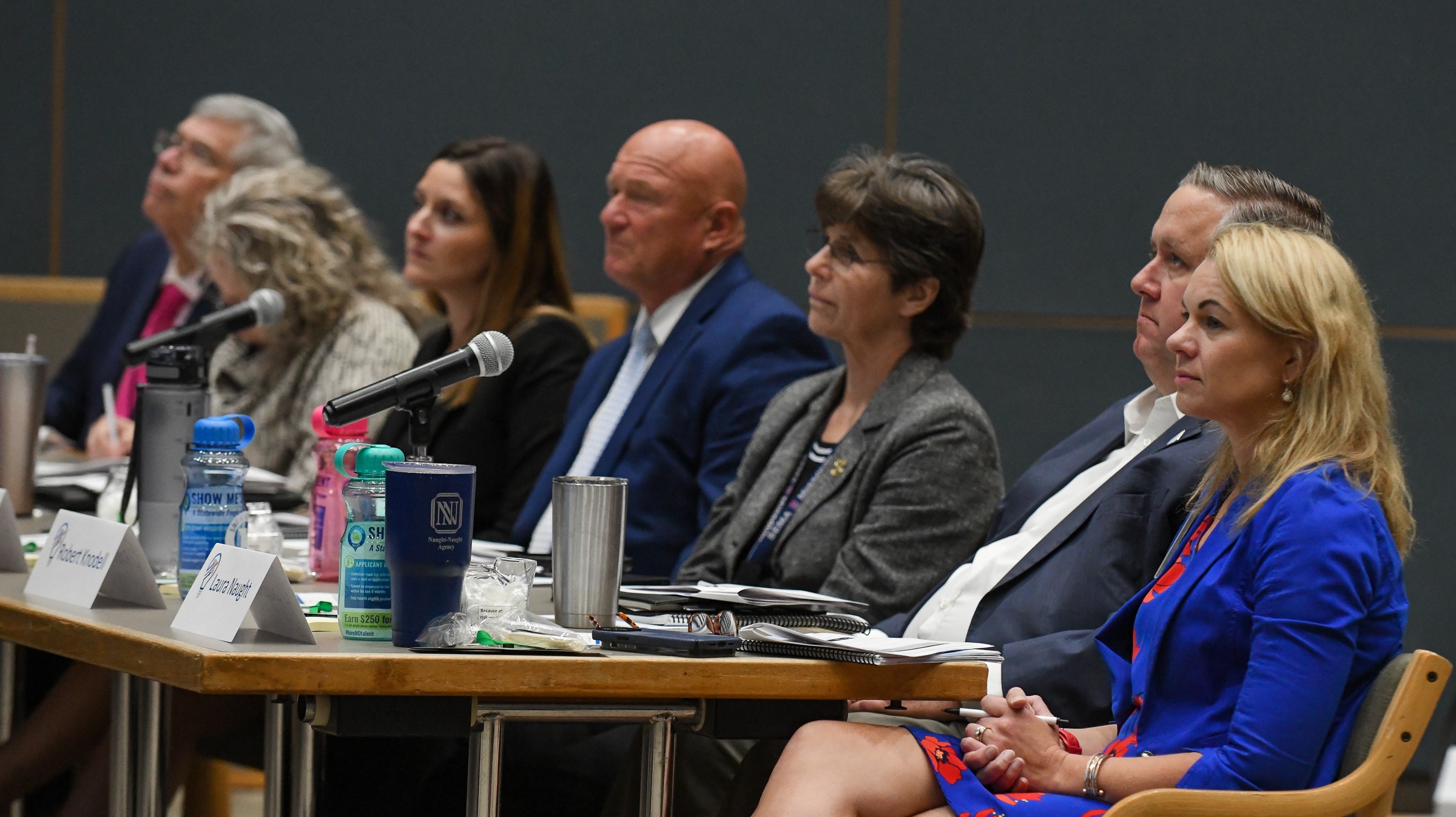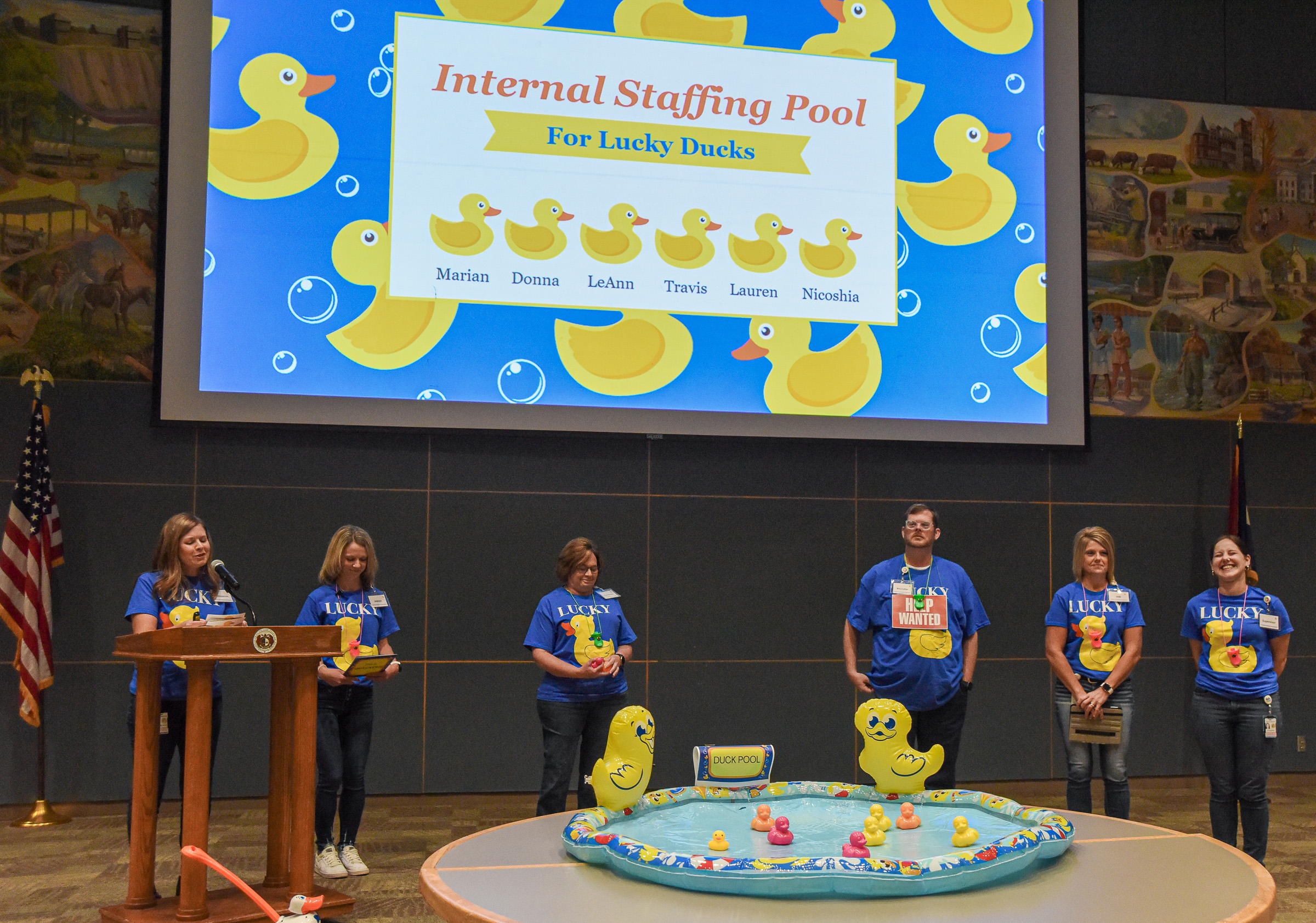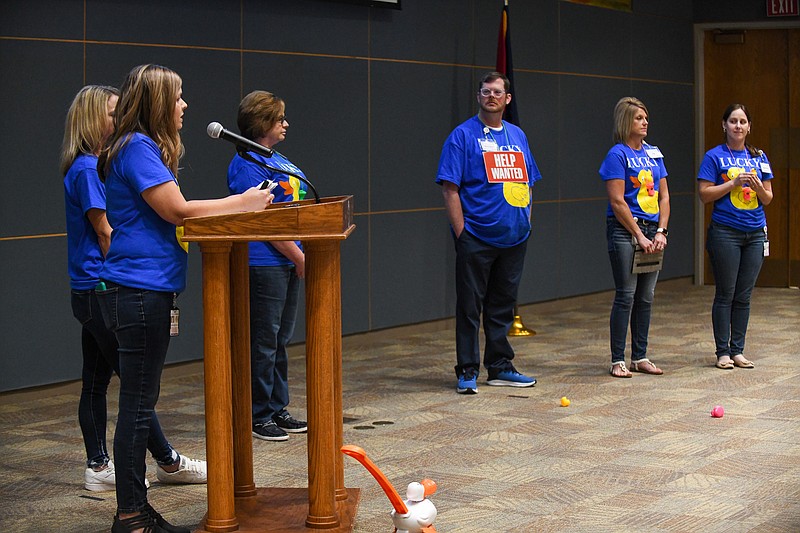Nine teams of state employees pitched ideas to make Missouri government more efficient Monday, a majority of which took aim at statewide recruitment challenges and operations within the Department of Social Services.
Four-day work weeks, a cash-incentive employee referral program and an internal pool of temporary employees were pitched to combat employee recruitment challenges plaguing most state agencies.
A mass alert system notifying foster homes of child placement needs, youth support specialists tasked with curbing the number of foster runaways and a streamlined youth information portal for foster parents were among the suggestions for DSS.
State employees pitched the ideas to state government leaders through the annual Show Me Challenge competition hosted by the Office of Administration.
Now in its sixth cycle, the competition features teams of state employees from across various agencies suggesting innovative ways to make Missouri government more efficient, both internally and externally. They're given five minutes to present and five minutes to field questions from judges.
This year's judges were: Robert Knodell, acting director of DSS; Jennifer Tidball, chief operating officer of DSS; Sandy Karsten, director of the Department of Public Safety; Wayne Wallingford, director of the Department of Revenue; Jamie Burch, deputy policy director for Gov. Mike Parson; Sen. Mike Bernskoetter, R-Jefferson City; and Laura Naught, deputy director of the Department of Health and Senior Services.
First up was a team from the DSS Children's Division, who pitched a mass alert system that would notify Missouri's 3,000 foster homes when a child is in need of a placement.
The group opened its presentation with a photo from the Phelps County office showing blankets and pillows under a case worker's desk, and they explained a child had slept there for hours in August while the worker made calls looking for a foster home.
After ruling out relatives, case workers spend an average of 6.7 hours searching for placement options in foster homes, presenter Beth Atkinson said.
"The worst part every time was having to sit near the worker as they called dozens of homes, knowing that every additional phone call meant the people before also didn't want me," the group quoted a foster parent who was in state care as a child.
It's also more expensive to keep children with case workers overnight than it is to find a foster placement, Atkinson said, because the state often has to pay the case worker overtime. The extra costs can add up to at least $14,000 in a single day, she said.
"In the last two months, four out of five members of this team have stayed overnight in the office with children at least once," Atkinson said. "To compound this issue, these placements can directly lead to a reduction in federal funding by affecting placement stability measures. Lastly, this contributes to worker stress and turnover."
The mass communication system would send placement requests through email, text message, pre-recorded phone calls and app notifications, and allow for back and forth communication between foster parents and case workers. An accompanying dashboard would allow the department to document and manage requests and responses, as well as send requests by location.
The software would be contracted through an outside firm, such as AlertMedia, which projected an annual cost of $20,000.
Another group from the DSS Children's Division pitched an idea to repurpose appropriated funds for vacant positions to hire six new youth support specialists around the state -- one for each of the state's regions.
Youth support specialists would be tasked with reducing the number of youth running away from foster placements. The employee would teach foster youth conflict resolution skills and become an expert in missing youth protocol, becoming the primary contact for monthly search efforts.
An average of 245 youth in foster care run away at least once per year, which team member Rene Brinkman said puts them at heightened risk for homelessness, criminal activity, suicide, human trafficking and substance use.
"Current trends show us that more and more foster youth are running away from their court-approved placements because they are in need of more support and intervention to stabilize themselves," Brinkman said.
DSS doesn't have mechanisms in place to identify youth who are at a high risk of running away or a preventative program to reduce it.
Of surveyed case managers, 91 percent said they support hiring youth support specialists, the group reported, and the state could save $4.4 million annually by keeping youth in assigned placements.
The final suggestion for DSS involved creating a digital platform for foster parents to directly access a child's documented medical and education history. The information is currently kept by case workers, who communicate it to foster parents.
The system would contain the child's prior medical history before entering care and, through an online portal, foster parents could update documentation while the child is under their care.
Preliminary estimates to build the web-based platform came in around $180,000, team member Dragan Vulic said.
To address staffing challenges, employees from the DSS Family Support Division pitched a 32-hour, four-day work week, which they said could be applicable to eligible state employees throughout Missouri agencies.
DSS has a turnover rate of 55 percent for frontline staff, and the average turnover rate across all state agencies is 29 percent (22 percent are voluntary resignations), the group shared.
Seventeen percent of hired state employees leave the job within 90 days, whereas the average time to fill positions is 67 days, with only six applicants per position, they continued.
The group pointed to pilot four-day work weeks in Iceland and the private sector as testament to the power it can have to drive productivity among employees. They said it can improve employee morale, work-life balance and engagement, as well as reduce janitorial and utility costs for agencies.
Customer service-facing roles likely wouldn't be eligible for the shortened work week so as to not interfere with citizen interactions with the state, the group said.
An employee referral program that offers state employees $250 for attracting a successful hire could also help the state's workforce issues, the "Show Me Talent" group proposed.
The state currently finds about 10 percent of its employees through referrals, making it the third largest source of applications, team member Dawn Sweazea said.
There are about 960 active job postings from the state and there are an average of 2.8 jobs per every Missouri job seeker, she continued. Before the pandemic, the state was attracting about 30 applicants per job post, but now it's lucky to get six.
Referred employees tend to stay longer than those that aren't referred, the group noted.
A cash-incentive referral program could bring the rate of vouched-for-hires from 10 percent to 20 percent, the group said. If the state was able to retain 20 percent of its vacancies last year, it would have saved $12.7 million in recruiting expenses.
"Just on our team alone we discovered in this program that three of us came to our current positions through a referral ..." Sweazea said. "So imagine what we could do if we actually put some oomph behind it and we worked really hard to hire 'MO' talent."
Phased pilots of the referral program are being implemented at OA, DOR, DSS and the Department of Agriculture starting in October.
The final idea for tackling workforce shortages came from an OA team, who pitched an idea to create a temp. agency-like system for state positions.
Division leaders could identify employment needs before they arise by looking at factors like upcoming retirements, promotions and planned leaves of absence, and then recruit from a limited pool of temporary state employees.
"When a vacancy is experienced, citizens are impacted through increased wait times, incurred overtime costs, stressed team members or paying temp agencies when we're in a crunch," the group said.
It can take months to fill open positions, but temporary employees could fill the vacancies within 10 days for a designated time period. The temporary employee pool would have two sections -- one for those looking for full-time, permanent positions and one for those looking for more seasonal or strictly temporary work.
The group said it would give the state a new employment pipeline filled with pre-screened, qualified applicants. That could be useful as more than a third of OA employees will be retirement eligible in the next five years.
Additional ideas pitched for the Show Me Challenge include implementing cancer screenings for state employees, consolidating DOR audit assessments into a single bill and offering state brain injury resources through a single, collaborative system or website.
OA will announce the winner of the competition later this week.
 Julie Smith/News Tribune photo: The judges panel for the Show Me Challenge on Monday, Sept. 26, 2022,, from near to far, consisted of : Laura Naught and Robert Knodell, both of Dept. of Health and Senior Services; Sandy Karsten of Dept. of Public Safety; Sen. Mike Bernskoetter; Jamie Birch from Gov. Mike Parson's office; Jennifer Tidball, Dept. of Social Services and Wayne Wallingford of Dept. of Revenue.
Julie Smith/News Tribune photo: The judges panel for the Show Me Challenge on Monday, Sept. 26, 2022,, from near to far, consisted of : Laura Naught and Robert Knodell, both of Dept. of Health and Senior Services; Sandy Karsten of Dept. of Public Safety; Sen. Mike Bernskoetter; Jamie Birch from Gov. Mike Parson's office; Jennifer Tidball, Dept. of Social Services and Wayne Wallingford of Dept. of Revenue. Julie Smith/News Tribune photo: Using the theme of a staffing pool, these individuals from the Office of Administration put forth their ideas for an internal staffing pool for the agency Monday, Sept. 26, 2022, during the Show Me Challenge. The annual event is an opportunity for state employees from any agency to put forth ideas to help make state government more efficient and responsive. From left to right are: Marian Buschjost, Nicoshia Roadruck, Donna Verslues, Travis Griffin, LeAnn Meyer and Lauren Doyle.
Julie Smith/News Tribune photo: Using the theme of a staffing pool, these individuals from the Office of Administration put forth their ideas for an internal staffing pool for the agency Monday, Sept. 26, 2022, during the Show Me Challenge. The annual event is an opportunity for state employees from any agency to put forth ideas to help make state government more efficient and responsive. From left to right are: Marian Buschjost, Nicoshia Roadruck, Donna Verslues, Travis Griffin, LeAnn Meyer and Lauren Doyle.
